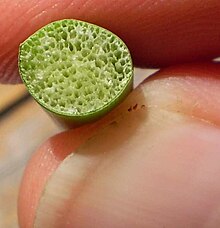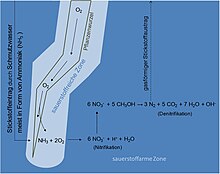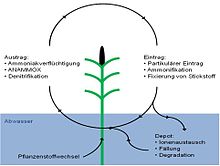Herbal sewage treatment plant

Plant-based sewage treatment systems are plants overgrown with plants, in which wastewater is cleaned by the interaction of plants in hydroponics , microorganisms , wastewater components and - with soil filtration - also the filter substrate.
There is a large variety of different plant-based sewage treatment systems. The systems can be divided according to the reference system ( aquatic - terrestrial ). So you get from overgrown bodies of soil via retention soil filters , slope irrigation and overflowing wetlands to swimming islands with an open water surface without a soil passage. If the procedures are broken down according to their effectiveness, in practice, overgrown horizontal and vertical filters according to DWA A 262 have proven themselves in large numbers for years and correspond to the generally recognized rules of technology. Two-stage vertical filters with raw sewage charging have proven themselves in large numbers in France for years (around 1000 systems, mostly for around 500 to 2000 inhabitants). Other types of systems (multilayer vertical filters, retention floor filters, sewage sludge soil, slope irrigation, swimming islands, swamp plant roofs, overflowing wetlands) are more or less common, but sometimes also correspond to the state of the art. In the planted soil filter (also known as a root sewage treatment plant), the wastewater is cleaned within a planted soil (root area), which - for a specific purpose (aim: the highest possible cleaning performance of the discharged sewage) - predominantly with reeds ( Phragmites australis ), supported by swamp or repositioning plants such as Cattails , rushes or sedges , is planted. The plant roots serve as a habitat for microorganisms that contribute to the breakdown of the wastewater constituents, as well as the entry of atmospheric oxygen, which also improves the cleaning performance of the system. Herbal sewage treatment plants are scientifically recognized as long as they can adhere to the limit parameters, as they correspond to the recognized rules of technology . A plant-based sewage treatment system can break down most of the substances in the water naturally.
This essentially happens through the interaction of filter material ( mechanical ), the absorption or breakdown of the water constituents by bacteria and organic processes ( biological ), adsorption on soil particles ( physical ) and precipitation reactions between the roots ( chemical ).
The wastewater flows through the sewage treatment plant either vertically from top to bottom or horizontally from the inlet gate to the outlet gate. Drainage pipes laid in the soil catch the cleaned wastewater and guide it into a control shaft. After this shaft, the purified water is discharged into a body of water, seeps away or stored for further use.
With vertical, intermittent operation, the best cleaning performance for this process (carbon degradation and nitrification) can be achieved.
The structure of a plant
Plant treatment systems consist of:
- A mechanical separation of the solid components. This can be done in three ways:
- In a settling basin (collecting shaft).
This is where the waste water constituents (the faecal sludge ) that are not dissolved in the water settle . In addition, those wastewater constituents that are lighter than water float on the surface. This collected sludge has to be disposed of. Disposal is required approximately once a year, depending on the size and load of the sedimentation system and the properties of the wastewater. There are also cases where the sludge partially dissolves itself through biological degradation in the sedimentation basin or the wastewater to be cleaned contains hardly any settable substances and therefore it is only necessary to empty it after several years. - In a dry filter basin with two chambers.
The filter consists of a fleece that is covered with a layer of coarse gravel and then with a layer of wood chips (only hardwood, as softwood has an antibiotic effect). The solids settle on the filter and remain in the air at all times. As a result, there are no rot and odor emissions. When the first chamber is full, the second is used.
The end product is compost mass. - Variation: The plant-based sewage treatment system is combined with a composting toilet . So there is no mixing of the solid and liquid components from the outset. This eliminates the acquisition and maintenance costs for the primary treatment and the space required for the sewage treatment plant is halved.
- The plant bed, mostly a basin (soil) overgrown with reeds and filled with gravel and sand . The wastewater is either fed into the sewage treatment plant via a gradient or a pump (usually at intervals) from the collecting shaft. Wastewater distribution systems that run on their surface and drainage pipes that run on the bed base in systems with flow from top to bottom bring the water to be cleaned into the soil and pull it off. Systems with a longitudinal flow are also being built, in which the wastewater is fed on one side of the plant basin and discharged on the other side. Several levels (plant basins) can possibly be switched one after the other. Basically, plant-based sewage treatment plants with vertical flow are characterized by high nitrification rates and low denitrification rates , whereas plant-based sewage treatment plants with horizontal flow are good denitrifiers and usually poorer nitrifiers. Open water sewage treatment plants with horizontal flow are similar to naturally occurring wetlands, but they have the significant disadvantage that they create ideal breeding conditions for mosquitoes.
- Before the purified water leaves the sewage treatment plant, it passes a control point. The required water quality ( BOD5 , COD , nitrogen , phosphorus ) can be measured.
End and inspection shaft
The inspection shaft is the last station before the water leaves the sewage treatment plant in a purified state. Here, the water quality must be analyzed using wastewater parameters. The authority usually stipulates the scope of the investigation when approving the facility. It can consist of self-monitoring to be carried out by the operator himself and external monitoring to be carried out by an independent testing institute.
In addition to the direct control of the water quality, the control shaft also has the function of regulating the internal water level. In some cases, wastewater is recycled from here. The flow of treated wastewater is halved and one half is fed back into the first or second chamber of the multi-chamber pit (primary treatment). This leads to a suppression of the formation of hydrogen sulphide in the primary treatment, a reduction in sludge, a "revitalization" of the wastewater already in the first stage - and overall better discharge values. In the case of systems that are charged on a free slope, waste water can only be returned with a pump. In the case of systems fed by a pump, the waste water can be returned via gravity.
The damming of the bed is done in some PKA types only in the start-up phase (about 3 months); other types are stowed permanently. The non-blocked operation brings the better drainage values, since it is richer in oxygen.
How the plant-based sewage treatment works
The cleaning performance of a plant-based sewage treatment system is achieved through the interaction of various processes. Each process has several functions. This is an extremely complex and natural cleaning process.
On the one hand, the water constituents are absorbed by the plants in order to meet the nutrient requirements of the plants as they grow. In addition, the roots of the reeds maintain the permeability of the soil (oxygen supply), which is reduced when stepped on or by deposits on the farm. On the other hand, most of the cleaning is done by microorganisms or bacteria that live in the soil. Both processes clean the water "biologically", that is, through biochemical reactions.
The microorganisms live and clean either:

- in an aerobic environment (oxygen-rich zone)
Many swamp and aquatic plants have adapted to a particularly low -oxygen environment in the course of evolution and have developed aerenchymatic tissue. This tissue enables the oxygen obtained in photosynthesis to be transported particularly effectively through the entire plant to the roots. Here, the oxygen is released into the water near the roots by diffusion , thus favoring autotrophic microorganisms that carry out the first cleaning step , nitrification .
- in an anoxic environment (low-oxygen zone)
The oxygen is only chemically bound, for example as the nitrification product nitrate . Microorganisms, which prefer a low-oxygen climate, convert this nitrate into elementary gaseous nitrogen as part of their metabolism , which escapes. The microorganisms required for this denitrification are heterotrophic and require a carbon source.
- in an anaerobic environment (oxygen-free zone)
In the absence of oxygen, a process that is mostly undesirable for reasons of odor nuisance, but it is used in special cases in anaerobic wastewater treatment .
In addition to other material cycles, such as the phosphorus cycle or the sulfur cycle, the nitrogen cycle is of outstanding importance, as most of the water cleaned by plant-based sewage treatment systems is contaminated by nitrogen compounds. The most important input types besides wastewater are particulate input, ammonification and fixation of atmospheric nitrogen. Particulate input takes place in the form of suspended particles in the water, which are physically filtered out of the water by the substrate in which the plants live and are finally added to the system through metabolism in the form of microbial biomass. In addition, ammonification also has an effect on the nitrogen balance. Here, organic nitrogen from bacterial biomass or plant residues is mineralized into inorganic nitrogen in an equilibrium reaction . In addition, small amounts of atmospheric nitrogen are dissolved in the water and added to the system. The main types of discharge from a plant-based sewage treatment plant are denitrification , ammonia volatilization and anaerobic ammonia oxidation ( anammox ). In addition to denitrification, the main cleaning effect, nitrogen is discharged through ammonia volatilization. Ammonia is in equilibrium in ionized and non-ionized form, while the non-ionized version of ammonia is relatively volatile and can thus be discharged from the system in gaseous form. The anammox process, in which ammonia is microbially metabolized to atmospheric nitrogen without an intermediate step, can make a significant contribution to the cleaning performance of a plant-based sewage treatment plant, especially in wastewater with low chemical oxygen demand. Apart from these inputs and outputs, precipitation , ion exchange and degradation represent nitrogen deposits . In addition to storage by precipitation, nitrogen is also accumulated according to the principle of the ion exchanger, especially in clay minerals. Furthermore, nitrogen is also stored in the system through degradation (dead plant residues), since nitrogen compounds in plant residues that are difficult to break down are not completely processed microbially by ammonification . The pH value and the temperature in the sewage treatment plant are of paramount importance when it comes to influencing the nitrogen cycle . In addition, phosphorus is a vital plant nutrient and can occur both as a depot and as a discharge. In the case of regular removal of the plant biomass, phosphorus can be removed from the system in this way, otherwise parts of the phosphorus contained in the plant remains remain in the system as a depot.
The water quality can be determined using so-called sum parameters or individual parameters such as nitrogen and phosphorus content. The carbon pollution of the wastewater is, for example, determined by the sum parameters
- BOD 5 (ATH) (inhibited biological oxygen demand: oxygen consumed by microorganisms within five days. Inhibition by allylthiourea (ATH) is necessary because otherwise an evaluation would not be possible because a more or less complete nitrogen oxidation would also be measured. ),
- COD (chemical oxygen demand: the oxygen consumed by catalytic-chemical conversions (oxidation)) and
- TOC (total organically bound carbon)
certainly.
Many sewage treatment plants may use iron chloride , iron sulfate or aluminum chloride to remove phosphate from the water if there is an oversupply of phosphate . This is done by the “iron” or “aluminum” converting the phosphate into a compound that is insoluble in water, which then “falls” to the bottom in the secondary clarifier (hence the technical term precipitation). In a plant-based sewage treatment plant, these precipitation reactions take place due to the iron salt or other minerals present in the soil . In addition, phosphorus is absorbed as a nutrient in the context of plant physiology and can thus be withdrawn from the water. However, this process can only be carried out if the grown plant biomass is regularly removed, as otherwise the phosphorus is returned to the water as it rots. In contrast to nitrogen, phosphorus cannot be separated in gaseous form, which also means that sewage treatment plants can absorb a finite amount of phosphorus.
Overall, the purified water from the end and inspection shaft can be used again for higher-value uses, taking into account the hygienic and technical regulations. This means closing the cycle and reusing and is particularly useful for water management in countries where there is a lack of water.
There is also a further development in which the bottom body is deliberately omitted. The plants stand on their own roots. The cleaning is mainly done by the plants themselves and by the microorganisms in their roots. Advantages include a lower overall weight and better air flow, which increases performance and can be used on roofs.
planning
The purchase price varies, it results from the costs for planning and construction, as well as from the acquisition of certain elements or materials such as a necessary sedimentation pit, in different amounts. It is important to what extent (connected EW) it was planned. Apart from that, the costs are even lower, they are largely due to ongoing maintenance, the disposal of solids (about once a year), and the control of the water parameters.
Plant sewage treatment plants must be carefully planned according to DWA A 262, this is necessary to guarantee a functioning plant. The planning costs depend on the size of the expansion. A plant-based sewage treatment plant is always based on population values or the population equivalent (EW or EEC). The minimum size is 4EW.
In order to avoid ecological consequences, the discharge values must be checked regularly. This monitoring is usually carried out annually by an authorized company, depending on the official requirements. The construction and discharge into a body of water or into the groundwater is subject to approval according to the respective regulations (in Germany the Water Management Act WHG and the respective law of the federal state or in Austria the Water Law Act WRG).
Conclusion
In most municipalities there is a compulsory connection to public sewage disposal. So you are forced to connect to the municipal sewage network, even if you have your own system. In Central Europe, the use of small wastewater treatment plants such as plant-based sewage treatment plants will therefore be limited to areas that have not been developed. However, plant-based sewage treatment plants can also be used to dispose of sewage in small towns and thus be used in place of other treatment processes.
Other obstacles to use could also be the space requirements (4 to 5 m² / inhabitant) or more extensive cleaning requirements (very high, secure removal of nutrients). No other negative properties are known. In addition, it can be stated that the cleaning process is odorless (since there are usually no standing water surfaces and anaerobic zones). The possible technical lifespan of plant-based sewage treatment systems is difficult to determine, as most of the systems are still operational (the first were built around 1980 ). However, replanting, possibly a renewal of the filter material and, in the case of compaction, loosening the soil is useful in order to maintain the desired drainage quality.
The plant-based sewage treatment plant is an alternative to the small sewage treatment plant based on the activated sludge process or a trickling filter . A body of water that can absorb the cleaned wastewater ( receiving water ) is advantageous for the drainage of the system . Or the purified water is fed into the groundwater or, if necessary, reused. In some cases, however, discharge into the groundwater is undesirable from a water management point of view for reasons of ensuring that the groundwater is kept clean (hygiene, residual pollution with non-degradable substances).
It is noteworthy that due to the ongoing processes, if properly executed, plant-based sewage treatment plants do not freeze in winter and are mechanically robust due to the extensive lack of units (apart from any pumps for sewage lifting). As the degrading bacteria are “anchored” in the soil matrix, they are not dependent on the sedimentation behavior of the activated sludge (see operating problems / bulky sludge formation in the activated sludge process ). This robustness of the process is a positive aspect when used in conditions in which intensive, daily maintenance cannot be guaranteed.
See also
Web links
Individual evidence
- ↑ Plant sewage treatment plant klaeranlagen-vergleich.de accessed December 23, 2012
- ↑ and compost toilets + sewage treatment system ( page no longer available , search in web archives ) Info: The link was automatically marked as defective. Please check the link according to the instructions and then remove this notice. , accessed February 6, 2011.
- ↑ Archived copy ( Memento of the original from December 13, 2014 in the Internet Archive ) Info: The archive link was inserted automatically and has not yet been checked. Please check the original and archive link according to the instructions and then remove this notice.



